Table of Contents
A Lab Approach for Marine CoLABoration
by Maja Kuzmanovic and Nik Gaffney
Improving the health of the ocean is one of the urgent, complex problems of our time. If it were simple to solve (e.g. with time, effort or money) it would almost certainly have been. The threats to the marine environment - and by extension to human wellbeing - are too entangled for neat single-issue solutions. Anything less than systemic change will be insufficient.This is no reason to become discouraged or to give up. Rather the opposite. It is a motivation to approach the issues from multiple points of view, to imagine, to experiment and to learn from failure; to appreciate what works and to understand how things could be systemically improved. This is the essence of the “lab approach”: enabling accelerated systemic innovation with reduced risk.
Marine CoLABoration is an example of using the lab approach to enhance flows of knowledge in the environmental sector, thereby developing the capacity needed to improve the health of the ocean. It was initiated by the UK branch of the Calouste Gulbenkian Foundation (CGF) “to explore how human values and the value of the ocean are reflected in individual and collective decision-making and can be utilised to increase ocean protection” (Marine CoLABoration mission statement). FoAM designed, facilitated and documented the lab process during its incubation phase. This article provides a reflection on the lab approach in general and on Marine CoLABoration as a specific case study.
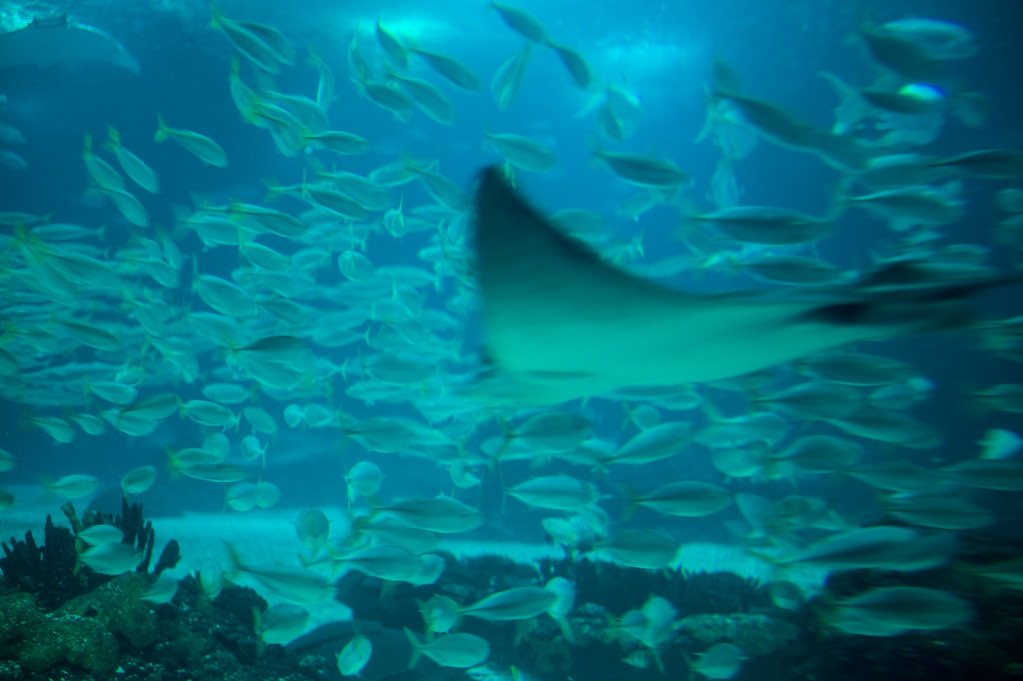
What is a lab?
The Lab evokes the smell of ozone, the excitement of experiment, the chaotically direct activity of ants, the energy of shared purpose and promise of adventures into the unknown. (…) We see labs as places where structured research can coexist with unstructured tinkering and exploration. Open enough to encourage serendipity, while retaining the rigor necessary to access, develop and spread knowledge.“ - From The Future of the Lab
Contemporary labs have many guises. The labs we talk about in this article are variously known as change labs, systems labs, civic labs, social or cultural innovation labs and so forth. The key characteristic of such labs is that they offer space for groups to investigate complex real world challenges and to collaboratively develop solutions.Lab participants learn from each other, continuously increasing the overall capacity of the group. Together they question the status quo, research alternatives, formulate ideas as hypotheses, conduct experiments and evaluate whether the lab’s work contributes to a desired systemic change. The lab structure is almost always a network, able to change its shape and scope depending on its needs and available resources. The culture of labs is open and inclusive, encouraging sharing of knowledge and resources as a commons.
This is a unique kind of laboratory - one that creates a dialogue, listening carefully with an open mind to all the voices, and then tries to translate them, mix them, and amplify them to prototype and develop alternatives. […] We embrace exploration and inclusivity, yet we’re ruthless in maintaining our focus on what works. We engage both the radical and the established, while remaining credible to each. Tension and ambiguity are inherent aspects of working in this fragile context. There is a craft, an art and a science to creating and evolving these “spaces in between” in order that the new might emerge.” - From Labcraft
While the manifestations and methods may differ, most labs share a few key aspects. Labs conduct experiments. Labs foster emergence. Labs evolve through collaborative creation and peer learning. Labs cultivate agile mindsets, heartfelt values and proactive cultures. Labs celebrate and support the inquiring spirit. Labs acknowledge that creativity comes in many guises and should be valued as a shared resource. The iterative, experimental nature of the work undertaken in labs stimulates the participants to become more adaptive to changing conditions.

What is the lab approach?
All of civilisation is one giant laboratory instrument, poking at the unknown.“ –Venkatesh Rao
In the lab approach ideas are formulated as hypotheses. A hypothesis is something like a “strong opinion weakly held”: it can be defended in an argument, yet can be discarded when faced with new evidence. In the words of Beth Comstock, “The word hypothesis sounds authoritative, but it actually means the opposite. (…) It’s a starting point, not an endpoint. In our accelerated world, we’re best served by taking stock of our assumptions and transforming as many as possible into hypotheses. (…) Thinking this way takes the pressure off, because we don’t feel like we have to know something that isn’t yet knowable. We’re free to let the future be the future.” The lab approach provides space for shaping hypotheses and a context in which they can be tested, strengthened or reformed, as a solid foundation for meaningful change.
What are the key aspects of the lab approach?
Space for emergence
Some of the most important discoveries in human history happened by chance. One of the main differences between the lab approach and goal-driven problem solving is the acknowledgement that seemingly aimless exploration can lead to surprisingly innovative results. It is important to leave room for the unexpected, the unplanned and the inconsequential. While this might sound simple, it isn't necessarily easy. Similar to improv theatre or music, the lab approach begins with designing a framework to encourage experimentation and improvisation. The lab approach creates and holds space for emergence.
“Creating space for emergence” is about structuring the spatial and temporal elements of the lab to encourage exploration and interaction, starting from seemingly trivial things like arranging furniture and allocating time. A well designed physical space provides opportunities for different types of activities and movement. It is therefore important to think about how the lab facilities can support rather than hinder collaborative processes. Nothing in a lab is taken for granted and everything can be questioned - including the lay-out of workspaces, facilities, spaces for focus, relaxation or socialising, etc. Everyone and everything in the lab contributes to its development. Similarly, the temporal flow of the lab process incorporates different rhythms and can be modified ad-hoc. Some activities benefit from long, meandering discussions, while others require quick, intuitive reactions. Different types of sessions are better suited for different times of day or even different seasons. Even the most expertly designed process can only ever be a sketch, to be adapted and refined during its implementation. This is where “holding space for emergence” becomes crucial. Holding space is about being alert and fully present; it is about appropriately responding to what is happening in the moment, while also keeping in mind the long view and the big picture. It encourages free exploration without loosing track of the intention the group set for themselves. Holding space is a skill that distinguishes exceptional improvisers and process facilitators, whose work goes beyond merely applying methods and techniques.
Participatory process, peer learning and co-creation
Co-creation and peer learning are the cornerstones of the lab-approach. The lab approach encourages participants to question, extend and borrow methods from each others' practices. Sometimes they constructively challenge assumptions, other times they find unexpected synergies between disparate approaches and ideas. The more diverse the participants' backgrounds, the more they can learn from each other. In a multistakeholder group, every person is an expert in some areas, and a novice in many others. One person's weakness is likely someone else's strength. When combined, they can complement and support each other. A participatory process - such the lab approach - connects individuals' diverse skills and personalities into a whole that can ideally become more then the sum of its parts. In a systems change lab no individual expertise can ever fully cover the breadth of subject matter. Realising just how interdependent we are (as individuals, collectives and societies) can be a humbling experience. Yet interdependence also brings about a sense of agency and responsibility - “what I do matters; my actions influence all other actions”. The lab process acknowledges individual contributions and engages each participant as a team member contributing to the group's collective intelligence.
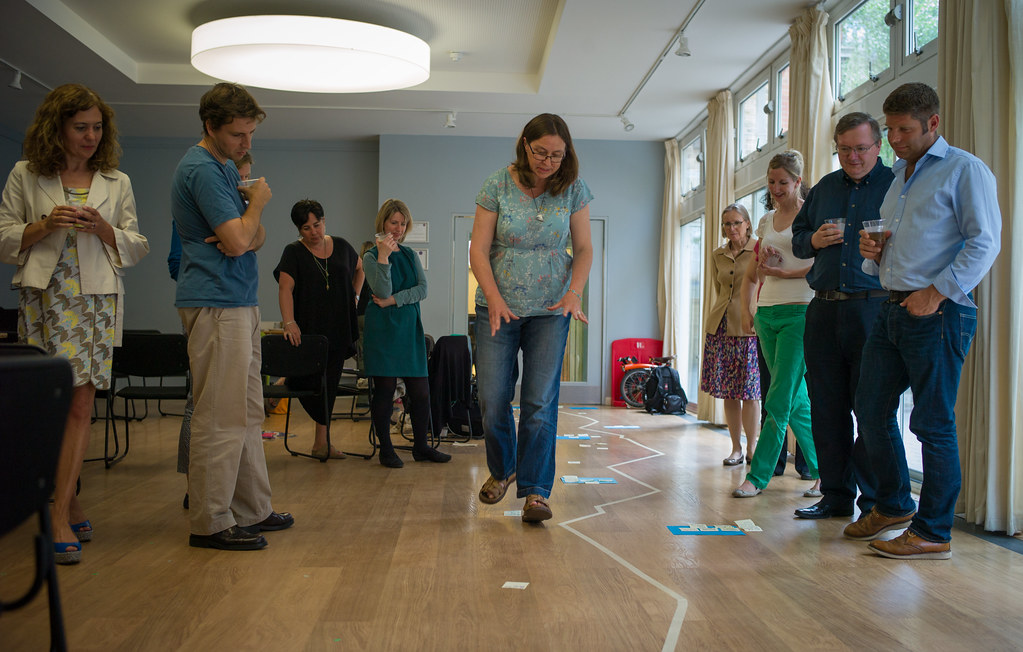
Participatory processes appreciate the importance of aligning personal and collective development, intellectual and experiential learning. Successful participatory processes include a multiplicity of formats that speak to a range of faculties - some participants excel verbally, others visually; some have a penchant for analysis, others for synthesis; some prefer introverted activities while others thrive in extroversion. Furthermore, the participants' faculties and preferences aren't a fixed constant. They depend on a range of internal and external influences, from things as visceral as back-pain to the a group being affected by shocking news. No process designer can ever plan for every contingency. So, how can participatory processes that work with the heterogeneity of aptitudes, experiences and personalities be designed? It is more akin to planting and tending a garden than building a highway. Process design is about finding a delicate balance between cultivating and letting grow, between guiding and stewarding.
Iterative Experiments
The word “laboratory” derives from the verb “laborare”, to work. So what is the “work” in the lab approach? The lab incubates and conducts experiments that contribute to desired systemic change. Experiments tend to be designed iteratively and usually include several cycles of research, implementation, prototyping, reflection and sharing. The process starts by finding a way to do the smallest thing possible that could contribute to achieving the larger vision. The experiments can scale up or change with every iteration, which can substantially reduce risk. The iterative, experimental nature of the work in a lab approach makes its outcomes more adaptive to changing conditions, and therefore more resilient and relevant in the long term. Some experiments succeed, others fail. Either outcome can provide useful data, as “compost” for the next iteration. The experimental process and results are openly shared and adapted as needed, assuring more effective systemic outcomes while avoiding catastrophic failures.
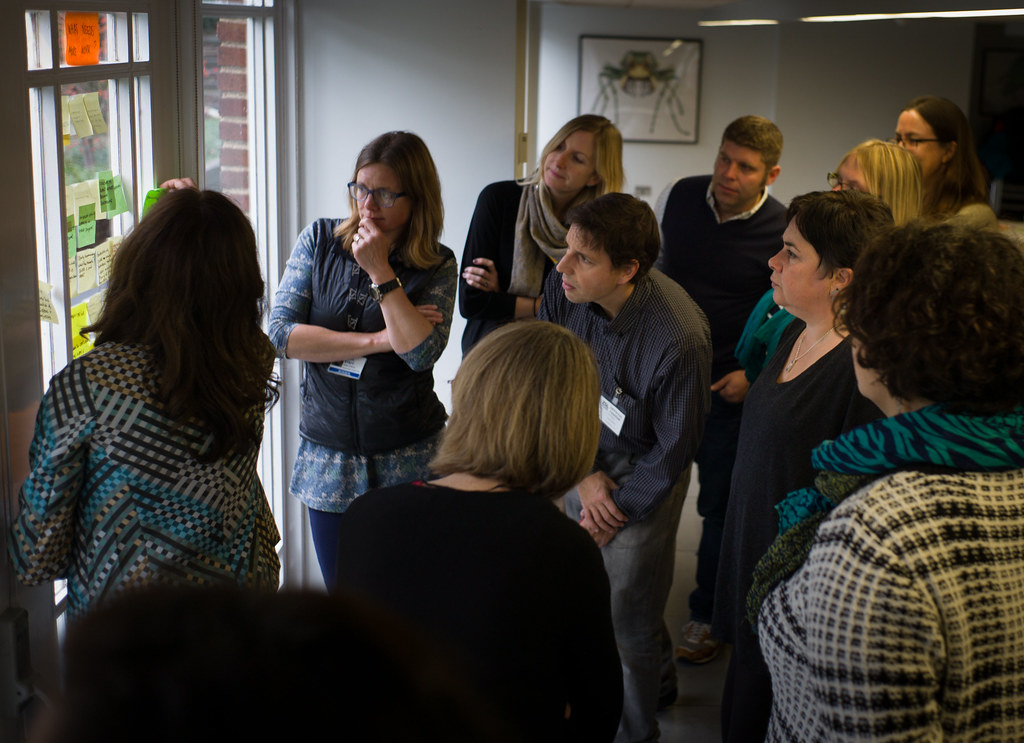
What could an experimental cycle look like? Each iteration of an experiment begins with the articulation of a relevant question or challenge, followed by examining the context, mapping the current situation and emerging tendencies. This research should be conducted in the field whenever possible and take into account all stakeholders (human and otherwise). “Learning journeys” are a particularly valuable way to collect information directly in the field, with people who are immersed in or affected by the issues the experiment is attempting to resolve. Based on information gathered in the research phase, experimenters formulate a hypothesis as a basis for a concrete, testable experiment. The first iteration of the experiment can be a simple prototype, designed in such a way that it can be completed in a short amount of time and with minimal resources. The challenge is to design the simplest possible experiment without loosing sight of the big picture; the prototype (no matter how crude) should test the hypothesis and provide useful answers for the larger, systemic questions. After the experiment is completed, the process and results are evaluated to find out wh.at worked, what didn't, what has been learned, and what can be improved. The insights are shared with the lab members and publicly if appropriate (to elicit feedback from a wider group of stakeholders). A new cycle then begins with adapting or refining the question, possibly expanding the context, creating a new hypothesis or reformulating the existing one, then gradually refining, branching or scaling the experiment. Experimental cycles begin and end with inquiry. Through multiple cycles the lab gradually accumulates capacity and extends its knowledge base, while simultaneously scaling the reach and impact of its results.
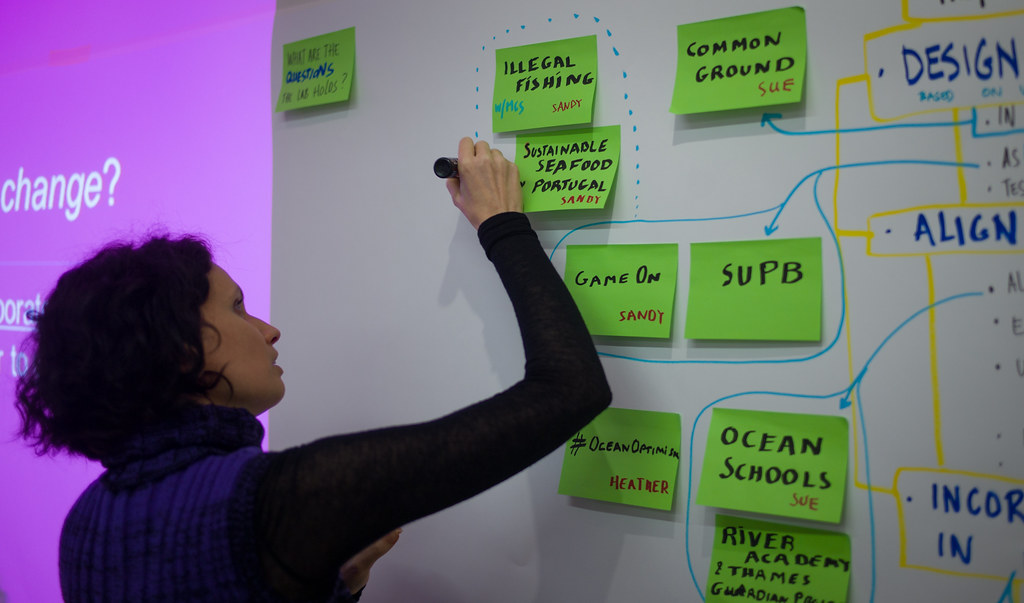
If there is to be an ecology of practices, practices must not be defended as if they would be weak. The problem for each practice is how to foster their own force, make present what causes practitioners to think and feel and act. But it is a problem which may produce also an experimental togetherness among practices, a dynamics of pragmatic learning of what works and how. This is the kind of active, fostering “milieu” that practices need in order to be able to answer challenges and experiment changes, that is to unfold their own force.” –Isabelle Stengers
Cultivation of mindsets, a community and a culture
Experiments provide tangible outcomes from a lab approach, but many of the long term benefits are intangible: the cultivation of values and mindsets, communities and cultures. Openness, adaptivity, curiosity, inclusion and diversity are some of the core values cultivated through the lab approach. Shared values and mindsets begin to evolve when a loose collection of individuals becomes a collective, a team, a community of practice grounded in mutual trust and respect. The transformation starts with open-minded dialogue and inspiring co-creation. It develops through collaboration and jointly confronting challenges. As a collaborative team matures, the supportive tasks of the community come to the fore, such as mentoring, advice and consulting. Underneath and in between the work, the participants get to know each other's diverse personalities and histories. They develop a deeper understanding of the various motivations and aspirations co-existing in the group. Unexpected connections can emerge more easily when the process incorporates informal social gatherings as an inextricable part of the lab. They can be as simple as shared lunch-breaks or dinners, or as involved as field trips, retreats and family outings. If the lab approach is to foster the development of a long-term community of practice, social aspects may need as much attention as designing experiments. The culture of the lab emerges gradually through interaction between work and sociality, as an embodiment of shared values and principles.
Liminal space […] was tricksterish and, like Raven stealing fire from the gods, I learnt one of the secrets of the universe: up close, the laws of possibility are not fixed. They can be risked, experimented with and gambled on. Between the boundary of what is possible and what is not there is a field: a space of transformation the universe only releases in the dusty arena of action, trying, failing and trying again. The threshold between what is and what could be is rich in potential for change. -Lucy Neal

Marine CoLABoration: a case study in the lab approach
Oceans cover more than 70% of the world’s surface. They support vital natural systems including climate regulation, fresh water circulation and carbon dioxide storage. Healthy oceans provide critical resources for the health, wealth and well-being of humanity, are under serious threat, and are difficult to protect.“ –Valuing the Ocean, CGF
The scope and scale of the challenges of the marine environment demand improved flows of knowledge and active collaboration between initiatives, sectors and regions. We are confronting ocean degradation in a world with an increasingly turbulent climate, dwindling natural resources, and uncertain political, economic and social futures,. The overlaps between these issues only add to their complexity. Solving one problem may complicate solving another. Information may be incomplete, the big picture may be unclear. It is obvious that traditional institutions are struggling and that single-issue problem solving won’t improve things overall. Yet it is also not clear what would. This is the beginning of the process: admitting what we don't know. This is the essential first step toward understanding. The lab approach creates conditions where “not knowing” becomes an invitation to find out, to become more open, curious and attentive to different perspectives, to discern actions that benefit the whole as well as its constituent parts.
In response to the complex challenges of ocean protection, the UK branch of the Calouste Gulbenkian Foundation (CGF) invited nine organisations concerned with the issues to form Marine CoLABoration using a lab approach. When the CGF approached FoAM to propose a lab programme for the first year, we received a clear set of objectives:
- enable the development of a cohesive, committed, collaborative group with a vision, clear objectives and plan of activities
- provide a participatory, high quality experience for the Lab members
- align shared purpose for the lab and the collaborations, specific to the selected group of people and the Gulbenkian team
- support the Lab process and capture learning through online discussion and documentation
- encourage “ownership” of the process by the group.
We brought together a team of three facilitators with diverse backgrounds, skills and personalities. Maja Kuzmanovic, Vali Lalioti and Nik Gaffney designed the programme of workshops and online services to support the the development of Marine CoLABoration as a transdisciplinary, inter-organisational lab. We provided a flexible framework and created initial conditions that enabled the group “to think differently and experiment with new ways of approaching problems in the real world”. In the first year of its existence, aside from forming the lab itself, the group had to begin to incubate experimental initiatives, which were able to “catalyse more effective solutions to marine issues”
In the spirit of the lab approach, we seized the opportunity to go about designing the process itself as an experiment. Our initial design was based on a set of hypotheses about what was needed to meet the ambitious objectives set forth by the CGF. During and after each workshop we asked for feedback from the participants and the CGF team. The process itself evolved through recurrent action research cycles, providing an in-situ example of the lab approach itself. FoAM’s year-long engagement allowed us to progressively adapt the process to the group, their context and their needs. Our final experiment was a gradual hand-over of process facilitation to the lab members.
Process
The first year of Marine CoLABoration progressed in two phases: a scoping phase and the transitional phase. The scoping phase was designed to encourage engagement, develop a collective vision and initiate some preliminary experiments. It was important to take time to foster commitment in the group. The participants appreciated that they “were not presented with an initial agenda, but were allowed to spend a lot of time to get to know each other.” By the end of the scoping phase the participants were ready to take on a more pro-active role in designing the lab sessions themselves. During the transitional phase the lab began to incubate larger experiments and to formulate longer term objectives and operational models. Throughout the year face-to-face collaboration during lab-sessions was complemented by continuous access to online discussion and documentation. The process and results were shared on a collaborative wiki, conceived as a growing collective memory.
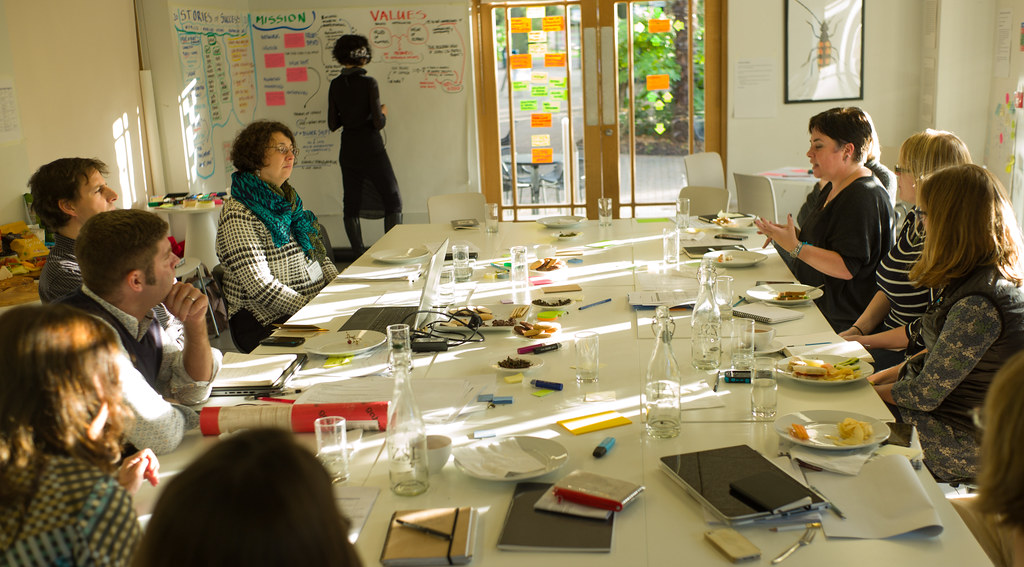
Every lab meeting began with specific questions. How could the Marine CoLABoration change the world? What do you need from Marine CoLABoration and what could you contribute? How does the Marine CoLABoration relate to the wider context of current work and emerging themes in the marine sector? What experiments could you design to respond to systemic challenges in the marine environment? What would you like to achieve as the Marine CoLABoration team? How will you know that you have achieved it? How will you organise yourselves in order to achieve it? What do you know about the past and the present of Marine CoLABoration, what do you aspire for the future? How could Marine CoLABoration become a self-sustaining community of practice? What is Marine CoLABoration and where is it going? Such questions were explored through a range of different sessions, which incorporated multiple ways of learning. For example, some sessions took the format of moderated conversations, others focused on visualising and enacting the ideas, others encouraged contemplative writing. Disparate sessions were collated together in a “flow” which lead towards concrete outcomes (e.g. sketches, prototypes, decisions). The outcomes from each session were used as starting points for another, where they could be questioned, debunked or developed further. The lab sessions themselves were regularly evaluated by everyone involved and adapted where needed. For example, while in the early scoping phase it was beneficial for the process to be designed by FoAM so the participants could fully focus on their work, it gradually became important for the participants themselves to take the lead in designing the lab sessions. They became more involved in all aspects of the process, which lead to increasingly taking “ownership” of the lab. By the end of the first year the group had become a closely knit team, working together on several values-based experiments (from reduction of plastic waste to testing ways to increase public engagement with the ocean).
As one of the participants noted,”the excellent facilitators and the diversity of organisations was important. There was respect for each others skills and ambition to do more together than our parts”. The lab process brought out the participants' willingness to share, communicate and work together. It enabled the group to align the work of the individuals (and their organisations) with the wider, systemic aims of the lab. It encouraged honest communication and inspired co-creation of common ground for long-term collaboration.
Emergence
One simple way to foster emergence in a lab is to begin the process by introducing participants to each other as creative humans. As one of the participants noted: “We were freed up from organisational responsibility and brought together also as individuals not feeling that we always had to represent our brands. Facilitation was very important”. It was our hypothesis that playful co-creation could bring people together quicker than an expert debate or power-point presentations. For example, the first encounters of Marine CoLABoration included comparing personal “worldchanging experiences”, visualising skills and personalities present in the group, and collaboratively designing future scenarios for the lab. Gradually, discussions shifted focus from individual to collective engagement. The first hypotheses and experiments emerged from participant-lead “open space” sessions about challenges with valuing the ocean in their current work: “The open space allowed us to explore what we wanted to know and what we wanted to do, without being pushed for results”. There was enough time and space for the participants to learn from each other, to learn by doing. Some ideas continued to develop and grow, others petered out. Collaborative teams were formed as required and dissolved when they became unnecessary. Rather than strictly directing the process, the lab approach encouraged fluid movement of ideas, inspiration and people. It brought to light where the participants' aspirations and energies lie. It allowed people to step up when leadership was called for and to forgo propositions if they had no traction. Marine CoLABoration became a “space to experiment with different ways of thinking and learning from others”. The direction of the lab emerged from the work done in the lab.
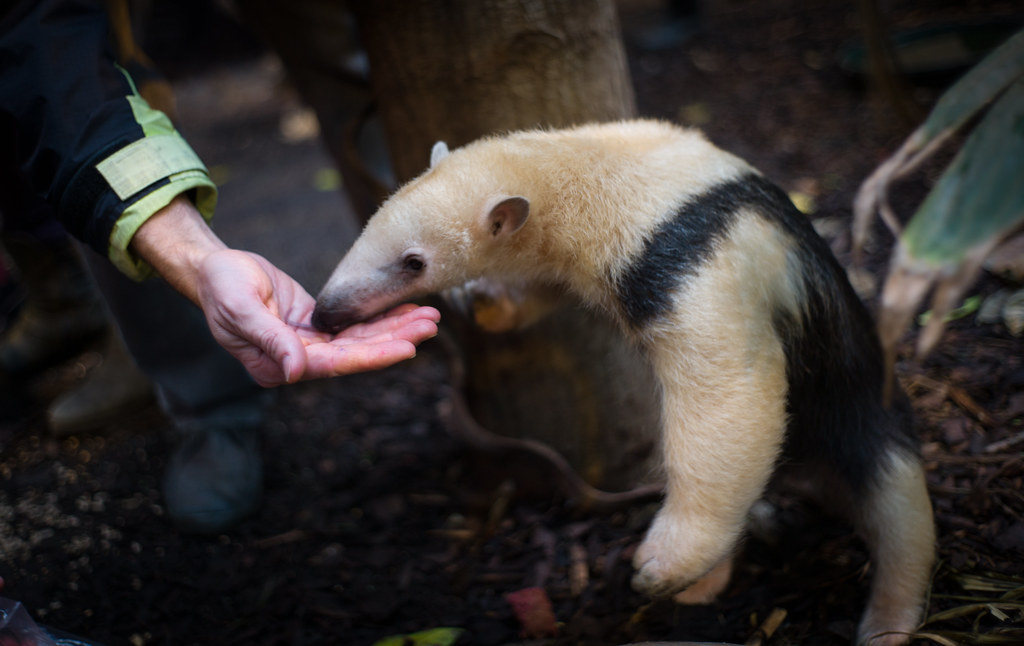
Experiments
The work in Marine CoLABoration consists of experiments conducted in “real life”, rather than in artificial, controlled conditions. Systems Change, Changing Perceptions and Public Engagement were the main challenges identified for the lab's first experimental cycle. With such monumental challenges it wasn't always straightforward to design “quick-and-dirty” prototypes. The disparity between the scale of the ambition and the availability of time and resources became abundantly clear. While this is exactly what a lab approach is meant to resolve, it can prove more time-consuming than expected to shift mindsets from large projects or campaigns to agile experiments. At the beginning it seemed counter-intuitive to tackle the complexity of valuing the ocean by formulating testable hypotheses and designing iterative experiments. The lab approach was only gradually adapted and adopted by the group, and was jointly tweaked to reflect the intentions that the participants set for themselves. By the end of the first year, the group began designing initiatives to include multiple action research cycles and were constructively challenging their assumptions as hypotheses. In the words of one of the participants, “Marine CoLABoration expanded my horizons and helped me link local to global ideas & solutions.”

In Marine CoLABoration several lab experiments exist simultaneously at different scales and duration. The experiments overlap, complement and confront each other, thereby increasing the lab's diversity and resilience. Over the course of the first year, some experiments were abandoned while others will become multi-year projects with experimental cycles lasting more than a year. For example, the experiment to “test the feasibility of using transparency of marine industry as a lever for change” has not developed beyond the preliminary phase, while the experiment to support “London to become free of single-use plastic bottles” has evolved into the larger #OneLess campaign. By the time FoAM's involvement with the Marine CoLABoration concluded, several experiments were in the middle of their first cycle. The experiments focusing on Systems Change and Valuing What Matters lead to wider principles for the collaboration, including a values based approach and action research. Our experiment in using the lab approach to enable “the development of a cohesive, committed, collaborative group with a vision, some clear objectives and plan of activities” had been successfully completed. The larger experiment of enabling the lab to become a self-sustaining community of practice was just beginning.
By articulating multiple hypotheses and designing several experiments, the Marine CoLABoration was able to explore valuing the ocean from different perspectives, using a range of methods (from events to games, systems mapping to storytelling). With the first experiments designed to last three months at most and require minimal resources, they functioned as “probes” to discover which ideas held sufficient traction in the group. When it was time to scale-up the experiments, the participants knew each other well enough to know which roles and responsibilities they could assume. Furthermore, by seeing the lab itself as an experiment, the group could explore alternatives to cross-organisational collaboration and the formation of a supportive community of practice.

Culture
As the Lab matures, it develops a unique culture. With Marine CoLABoration this process was well underway by the end of the first year. As the participants noted, their involvement wasn't just about “doing” experiments in a lab but also about “being” part of a community: “our personalities meshed well together and there was room for laughter, room for fun and that created trust.” Field trips and site-specific multi-day workshops have proven to be highly effective for cultivating a sense of community. This became apparent during the Marine CoLABoration's visit to Portugal, that included learning journeys, lab sessions, long bus-rides and plenty of time to socialise. We began to notice a growing number of feedback loops between the participant's organisations; insights and methods from the lab were taken back to the organisations, and vice-versa; new people became involved in the lab initiatives or would function as advisers. “Personally, it has helped me realise that my ideas are valid and my way of thinking is creative and solutions based. My confidence has grown. I feel privileged to be considered a useful member of this inspiring group of people”.
The increased interest and involvement from the participants' organisations assured us of the initiative's longevity over the long term. One of the participants stated that “Marine CoLABoration has grown my professional network” and another “This is genuinely the cutting-edge of social change and I cannot stress enough what a unique opportunity this is”. Enlarging and connecting the networks of the individual participants and the lab as a whole is an important aspect of the lab approach. It can lead to intrinsic changes in mindsets and worldviews, that are slow to evolve but also result in deeper and more fundamental impact. One of the critical tests for Marine CoLABoration in its near future is to prove its relevance and extend it's involvement with a wider group of stakeholders. If the lab culture can be taken up, reproduced and adapted across different contexts, it can inspire and engage a growing number of people, leading towards widespread systemic change.

Conclusion
Ocean protection is in urgent need of bold alternatives. The lab approach enables prototyping these alternatives as collaborative experiments. Experiments whose scope, scale and effectiveness can increase with every iterative cycle. The lab approach amplifies small successes and avoids grand failures. It aims to find unexpected answers to obvious problems and obvious answers to unexpected problems. It encourages the participants to find entry-points to meaningful interventions, to explore, expand and open up. As such, it is not limited to ocean protection. The lab approach can adapt to many contexts and work with many different groups of people. It can negotiate divergent needs and worldviews in an ongoing process of trial and error. Rather than attempting to find consensus (which may not exist) on how to solve a problem (which may not be clearly understood), the lab approach addresses issues through a dynamic ecosystem of collaborative initiatives, with heterogeneous objectives and outcomes. Inspired by the complexity and resilience of living organisms, the lab approach calls for multiplicity and diversity, for complementary and contrasting solutions. For co-existence and co-creation with humans and non-humans alike.
The Marine CoLABoration is an example of how the lab approach can work in practice. It supports collaboration in a diverse group of motivated participants, combining their individual ambitions into meaningful joint initiatives. While the lab's experiments advance through agile cycles, it takes time to develop shared purpose and structure. If the lab continues to evolve and increase its influence with stakeholders, the Marine CoLABoration can drive systemic and cultural changes with substantial impact. The lab approach is one of many possible ways to address ocean protection. It is not necessarily the best nor the only one. However, it certainly has its place in the “ecology of practices” engaged in improving the health of the ocean. In the two years of its existence, the Marine CoLABoration has shown how the lab approach can lead to novel ways to connect with the ocean and inspire hope, even in places where optimism is in short supply.
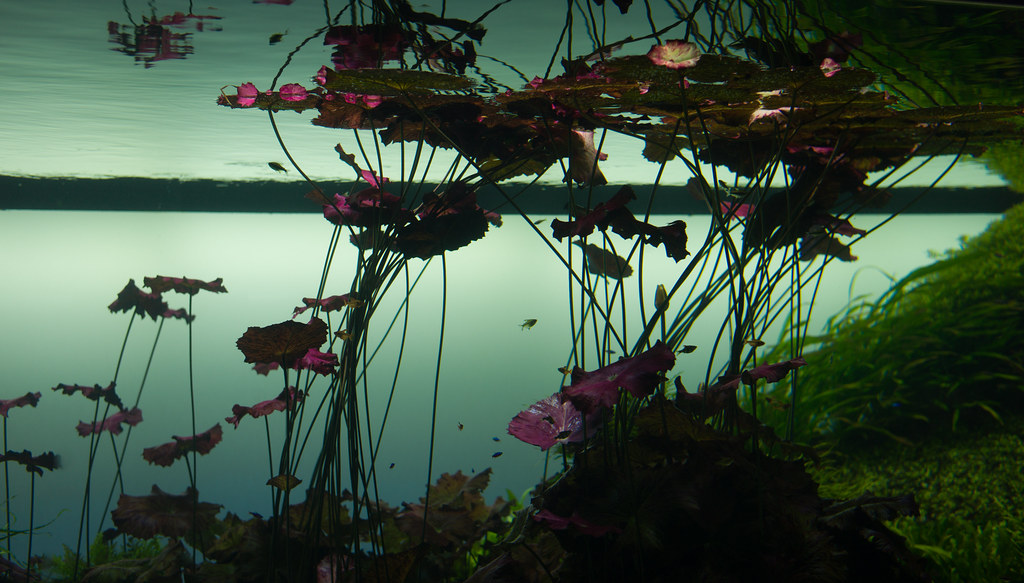
References
- Beth Comstock (2016): How to make uncertainty useful. https://journal.thriveglobal.com/how-to-make-uncertainty-useful-dd5102ed7a8e
- Nik Gaffney et al. (2010). Future of the Lab. http://lib.fo.am/future_of_the_lab
- Lucy Neal (2015). Playing for Time. http://www.lucyneal.co.uk/#/playing-for-time/4566233512
- Horst Rittel (1972) On the Planning Crisis: Systems analysis of the first and second generations.
- Isabelle Stengers (2005) “Introductory Notes on an Ecology of Practices.” Cultural Studies Review, vol. 11, no. 1.
- Hendrik Tiesinga et al (2014). Labcraft. http://labcraft.co/
Quotes from Marine CoLABoration participants are from internal feedback, some of which can be found at http://lib.fo.am/marine_colab/
Acknowledgements
We would like to thank Vali Lalioti for contributing her team-coaching and business innovation expertise to designing and facilitating the process, Louisa Hooper and Andrew Barnett for their vision, engagement and co-ordination, The Marine CoLABoration members for their creativity and commitment and everyone at CGF UK for their support.
Maja Kuzmanovic and Nik Gaffney are co-founders of FoAM, a network of transdisciplinary labs at the intersection of art, science, nature and everyday life. Their work can be found on the FoAM website and you can follow FoAM on twitter @_foam
